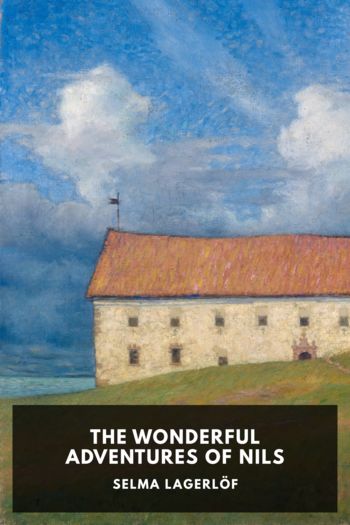The Wonderful Adventures of Nils by Selma Lagerlöf (i can read book club TXT) 📕

- Author: Selma Lagerlöf
Book online «The Wonderful Adventures of Nils by Selma Lagerlöf (i can read book club TXT) 📕». Author Selma Lagerlöf
Then Akka craned her neck, snapped hard with her wings, and rushed on at full speed. Now she had something to go by. The gray goose had told her not to light on Öland’s southern point, because there was a cannon there, which the people used to shoot the mist with. Now she knew the way, and now no one in the world should lead her astray again.
Öland’s Southern PointApril third to sixth.
On the most southerly part of Öland lies a royal demesne, which is called Ottenby. It is a rather large estate which extends from shore to shore, straight across the island; and it is remarkable because it has always been a haunt for large bird-companies. In the seventeenth century, when the kings used to go over to Öland to hunt, the entire estate was nothing but a deer park. In the eighteenth century there was a stud there, where blooded racehorses were bred; and a sheep farm, where several hundred sheep were maintained. In our days you’ll find neither blooded horses nor sheep at Ottenby. In place of them live great herds of young horses, which are to be used by the cavalry.
In all the land there is certainly no place that could be a better abode for animals. Along the extreme eastern shore lies the old sheep meadow, which is a mile and a half long, and the largest meadow in all Öland, where animals can graze and play and run about, as free as if they were in a wilderness. And there you will find the celebrated Ottenby grove with the hundred-year-old oaks, which give shade from the sun, and shelter from the severe Öland winds. And we must not forget the long Ottenby wall, which stretches from shore to shore, and separates Ottenby from the rest of the island, so that the animals may know how far the old royal demesne extends, and be careful about getting in on other ground, where they are not so well protected.
You’ll find plenty of tame animals at Ottenby, but that isn’t all. One could almost believe that the wild ones also felt that on an old crown property both the wild and the tame ones can count upon shelter and protection—since they venture there in such great numbers.
Besides, there are still a few stags of the old descent left; and burrow-ducks and partridges love to live there, and it offers a resting place, in the spring and late summer, for thousands of migratory birds. Above all, it is the swampy eastern shore below the sheep meadow, where the migratory birds alight, to rest and feed.
When the wild geese and Nils Holgersson had finally found their way to Öland, they came down, like all the rest, on the shore near the sheep meadow. The mist lay thick over the island, just as it had over the sea. But still the boy was amazed at all the birds which he discerned, only on the little narrow stretch of shore which he could see.
It was a low sand-shore with stones and pools, and a lot of cast-up seaweed. If the boy had been permitted to choose, it isn’t likely that he would have thought of alighting there; but the birds probably looked upon this as a veritable paradise. Ducks and geese walked about and fed on the meadow; nearer the water, ran snipe, and other coast-birds. The loons lay in the sea and fished, but the life and movement was upon the long seaweed banks along the coast. There the birds stood side by side close together and picked grub-worms—which must have been found there in limitless quantities for it was very evident that there was never any complaint over a lack of food.
The great majority were going to travel farther, and had only alighted to take a short rest; and as soon as the leader of a flock thought that his comrades had recovered themselves sufficiently he said, “If you are ready now, we may as well move on.”
“No, wait, wait! We haven’t had anything like enough,” said the followers.
“You surely don’t believe that I intend to let you eat so much that you will not be able to move?” said the leader, and flapped his wings and started off. Along the outermost seaweed banks lay a flock of swans. They didn’t bother about going on land, but rested themselves by lying and rocking on the water. Now and then they dived down with their necks and brought up food from the sea-bottom. When they had gotten hold of anything very good, they indulged in loud shouts that sounded like trumpet calls.
When the boy heard that there were swans on the shoals, he hurried out to the seaweed banks. He had never before seen wild swans at close range. He had luck on his side, so that he got close up to them.
The boy was not the only one who had heard the swans. Both the wild geese and the gray geese and the loons swam out between the banks, laid themselves in a ring around the swans and stared at them. The swans ruffled their feathers, raised their wings like sails, and lifted their necks high in the air. Occasionally one and another of them swam up to a goose, or a great loon, or a diving-duck, and said a few words. And then it appeared as though the one addressed hardly dared raise his bill to reply.
But then there was a little loon—a tiny mischievous baggage—who couldn’t stand all this ceremony. He dived suddenly, and disappeared under the water’s edge. Soon after that, one of the swans let out a scream, and swam off so quickly that the water foamed. Then he stopped and began to look majestic once more. But soon, another one shrieked in the same way as the first one, and then a third.
The little loon wasn’t able to stay under water any longer, but appeared on





Comments (0)